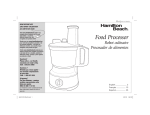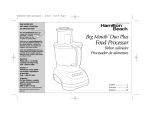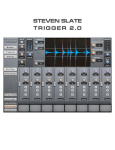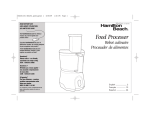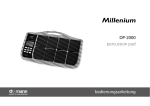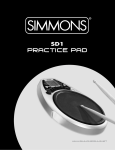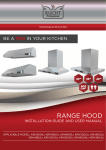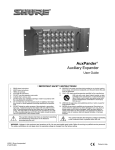Download USER GUIDE
Transcript
USER GUIDE Written by: Alex Semichev Sergey Danilov Edited by: Blake Eiseman Steven Slate Dax Liniere Document Version 1.4 (3/8/2011) Product Version 1.65 (3/8/2011) Thanks to the Slate Digital Beta Test Team, who were invaluable not just in tracking down bugs, but in making TRIGGER as good as it is. Contacting Support For any questions, comments, or tech support, please do not hesitate to contact us at: http://www.slatedigital.com/support/ If you have problems with a triggering setup for any particular track, feel free to send us the track and we’ll help you find the optimal triggering settings for your track. We’re always happy to help you! Slate Digital LLC USA 11559 Dona Evita Drive Studio City, CA 91604 www.slatedigital.com © 2011 Slate Digital LLC. All rights reserved. Installation iLok License Download Before downloading the iLok license for TRIGGER, make sure you have installed the latest iLok drivers for your system. You can download the latest installers here: iLok drivers for Mac OS: http://sw.ilok.com/macextsx.dmg iLok drivers for Windows: http://sw.ilok.com/DriverSetup.exe In order to download the iLok license to your iLok dongle, please visit the link that was given to you in your email receipt and enter the required info including the issued passcode. This will unlock your iLok redemption code. Use this code via your iLok account's "Redeem License Code". Enter the license code, and then download the license on your iLok dongle. Installing TRIGGER To install TRIGGER, please follow these simple steps: 1) Create a new folder for the TRIGGER instruments and extract the “Deluxe”, “Kicks”, “Snares” and “Toms” folders from the instruments ZIP files. 2) Run the TRIGGER installer for your system (Mac OS or Windows). 3) Launch your audio program and insert TRIGGER plugin onto a track. 4) Press the Settings button in TRIGGER. 5) Press the Browse button in the Instruments and Presets Path section and choose the folder with TRIGGER instruments. Table of Contents 1 What is TRIGGER? ................................................................................. 5 2 System Requirements ........................................................................... 6 2.1 PC Requirements ................................................................................................. 6 2.2 MAC Requirements ............................................................................................. 6 3 User Interface........................................................................................ 7 3.1 Settings ................................................................................................................. 7 3.2 Browser ................................................................................................................ 8 3.3 Main Display ........................................................................................................ 8 3.4 Triggering Controls............................................................................................ 10 3.5 Instruments Controls ........................................................................................ 11 3.6 Dynamics and Velocity Curves ......................................................................... 12 3.7 Articulations Display ......................................................................................... 13 3.8 Midi Capture ...................................................................................................... 14 4 Keyboard Keys and Mouse Buttons .................................................... 16 4.1 How to Unload Instruments............................................................................. 16 5 TRIGGER Drum Samples Library .......................................................... 17 5.1 Dynamics Settings for Different Types of Samples........................................ 18 6 Triggering ............................................................................................ 19 6.1 Triggering without Leakage Suppression........................................................ 19 6.2 Triggering with Leakage Suppression ............................................................. 19 6.3 High-Pass Filter .................................................................................................. 21 6.4 MIDI Input .......................................................................................................... 21 6.5 MIDI Output ....................................................................................................... 21 6.6 MIDI Capture ..................................................................................................... 23 6.7 Getting the Most from TRIGGER ..................................................................... 24 7 3rd Party iLok License Transfer Fee .................................................... 26 1 What is TRIGGER? SLATE DIGITAL’s TRIGGER is the next generation drum replacement VST/RTAS/AU plugin. TRIGGER has a phase accurate multi layered triggering engine. This means that in one instance of the plugin, you can seamlessly trigger multiple samples simultaneously, such as a close mic sample, stereo overhead sample, and a stereo room mic sample. Or, mix many direct mic samples to develop your own custom unique sounds. This multi-channel triggering functionality allows the user to recreate the sound of natural drums with real multitracked samples. Each sample layer has parameters for customization such as velocity and dynamic control, attack, sustain, release, and independent levels. Other features include: 2 detection modes, MIDI capture, MIDI in/out, automation for most parameters, up to 127 different articulations per instrument, up to 127 velocity layers per instrument, up to 127 alternating hits per velocity layer, and a unique “Leakage Suppression” function. 2 System Requirements 2.1 PC Requirements Hardware: any Intel or AMD processor with SSE2 support, 1 GB of RAM Operating system: Windows® XP, Windows Vista® (32/64 Bit), Windows 7® (32/64 Bit) 2.2 MAC Requirements Hardware: Mac PowerPC G5 or any Intel processor, 1 GB of RAM Operating system: Mac OS® X 10.4 or later 3 User Interface 3.1 Settings 1 - Settings. Toggles the visibility of the Settings display, which will appear at the top of the TRIGGER window (in place of the waveform display). 2 - Detection Mode. Switches the TRIGGER detection mode between Live (with closer to zero latency) and Accurate (with 11 ms latency). Attention! If you’re using a host application that has latency compensation, you have to turn TRIGGER off and then turn TRIGGER on after switching Detection Mode, because the plugin should be restarted to make sure the host obtains new plugin latency info. 3 - Midi In. Turns on and off MIDI in. 4 - Midi In Note. Sets the MIDI in note number and channel. 5 - Midi Out. Turns on and off MIDI out and selects the MIDI port to use for output. 6 - Midi Out Note. Sets the MIDI out note number and channel. 7 - Articulation/Positional Sensing CC. Sets the MIDI CC to change the instrument’s articulations. You can also change articulations using automation in your host. 8 - Instruments and Presets Path. Sets the TRIGGER instruments and preset path. Click on the Browse button to set the path. 3.2 Browser The main purpose of the Browser is to allow you to browse any number of TRIGGER-relevant files, load them, and save TRIGGER presets. 1 - Show Presets. Toggles on and off the visibility of TRIGGER presets, which have a blue icon and .prs file extension. 2 - Show Instruments. Toggles on and off the visibility of TRIGGER instruments, which have an orange icon (pink icon for WAVs and AIFs) and .tci file extension. 3 - Save Presets. Opens a Save Preset dialog. 3.3 Main Display The Main Display is a significant TRIGGER interface element, which has a few different functions. It displays the waveform of the original signal (blue and red) and triggering guide lines (orange flags), which helps in triggering adjustments. It also contains some functions at the upper left corner: 1 - High-Pass Filter. Attenuates all frequencies below the cutoff point, leaving frequencies above unaffected. Use the high-pass filter to reduce low frequency signal in the original audio. This can be useful on very deep kick drums or toms to improve the triggering quality. HPF has a guide gradation, which helps in making adjustments to the HPF. Values from 0 to 200 Hz are typical for snare, some kick drums and toms, and values from 200 to 1000 Hz are typical for deep and long sustained kick drums and toms. To adjust the high-pass filter, place your mouse cursor over the HPF title, hold down the left mouse button and move your mouse cursor up or down. 2 - Mix. Sets the mix level between the original signal and the replaced samples. To adjust the mix level, point your mouse cursor over the MIX title, hold down the left mouse button and move your mouse cursor up or down. 3 - Leakage Suppression. Sets the level (threshold) of leakage suppression. To adjust the suppression level, point your mouse cursor over SUPP title, hold down the left mouse button and move your mouse cursor up or down. Read more about Leakage Suppression in section 6.2. 4 - Selected Instrument Channel Audition. Allows user to audition all dynamic (velocity) layers of selected instrument by clicking on display from the bottom to top. 5 - All Instruments Channels Audition. Allows user to audition all dynamic (velocity) layers of all instruments loaded into TRIGGER by clicking on display from the bottom to top. Attention! Some hosts (such as Apple Logic) disable the audio engine whenever the transport is stopped. Audition will not work in these hosts unless you turn on the realtime audio monitoring on tracks with TRIGGER. 8 - Zoom Mode. Turns On and Off the Zoom Mode for Main Display. 3.4 Triggering Controls 1 - Input Level. Adjusts the input level of the original signal (original drum track). Use this to get the initial response, and then use the articulations, dynamics curve and velocity curve functions described below. 2 - Sensitivity. Sets the engine’s sensitivity level. Use lower values to avoid triggering unwanted leakage. Use higher values to trigger something very complex like low volume, very quick rolls. 3 - Retrigger. Sets the retrigger time (minimal interval between hits). Depending on the Retrigger value you can see the red colored part of the wave on the Wave Display. This red part of the wave, which appears just after the detected hit, is a visual representation of the retrigger interval. It shows how long TRIGGER remains “blind” and will not analyze incoming sound data for a new hit occurrence. It helps to tune the Retrigger interval quickly and easily. Use higher Retrigger values to eliminate the double hits (false flams) on noisy or overcompressed tracking. Be careful to not set the Retrigger value too high. If you set it too high, the plugin will not detect flams and rolls correctly. Note: If you have flamming on Retrigger values up to 35-45 ms, try to set HPF around 30-500 Hz before increasing the Retrigger value. 4 - Detail. Sets the level (threshold) below which the plugin will not trigger the signal (leakage, noise and other unnecessary signals). Try to avoid setting Detail level to high values, or to zero. Set it according to original audio leakages and other noise level. 5 - Output Level. Adjusts the TRIGGER output volume. 3.5 Instruments Controls 1 - Instruments Section. This section contains a six channel instrument mixer. This means you can load up to six TRIGGER instruments in one instance of TRIGGER. To load a TRIGGER instrument, select any instrument channel (left mouse click on any channel button and it will highlight) and then double click on any TRIGGER instrument file in the Browser. You can also load a TRIGGER preset, which can occupy from one to all six channels, depending on what the preset contains. To unload instruments from any channel, press the Ctrl key and left mouse click (or just right mouse click without pressing any keys on keyboard) on any instrument channel button, then press “Yes” in the Clear Slot dialog. Attention! TRIGGER has its own instruments format (.tci), but you can use any WAV or AIFF file as well. 2 - Volume. Adjusts the volume of the selected instrument. 3 - Pan. Adjusts the pan of the selected instrument. 4 - Tune. Adjusts the pitch of the selected instrument. 5 - Solo. Turns on and off the solo mode of the selected instrument. 6 - Mute. Mutes and unmutes the selected instrument. 7 - Phase Invert. Turns on and off the phase invert for the selected instrument. 8 - Attack. Sets the initial time it will take the envelope of the selected instrument to reach its maximum level after it has been triggered. Larger values will smooth out the attack phase that corresponds to increasing audio levels. 9 - Sustain. The fixed time that the envelope of the selected instrument will stay at its maximum level after it has completed the attack phase and before it enters the release phase. 10 - Release. The time it will take the envelope of the selected instrument to fall from its sustain level back to zero. 11 - Instrument Volume and ASR Envelope Display. Displays the volume, attack, sustain and release of the selected instrument. 3.6 Dynamics and Velocity Curves 1 - Curve Level. Adjusts the selected curve type level. Attention! Every instrument on each channel has its own independent curves. 2 - Dynamics Curve. Selects the dynamics curve type to adjust with the Curve Level knob. Use the Dynamics Curve to increase or decrease the dynamic range of the instrument. Lower values will make the softer velocity layers sound louder (decrease the dynamic range). Upper values will make the softer velocity layers sound softer (increase the dynamic range). 3 - Velocity Curve. Selects the velocity curve type to adjust with Curve Level knob. Use the Velocity Curve to adjust the response of the instrument. The 0.50 value of the Velocity Curve sets a linear response for the selected instrument. Values more than 0.50 set a positive non-linear response (which means if you trigger a soft hit on your drum track, it will be replaced by a hard hit from TRIGGER, or if you trigger the 64 velocity, TRIGGER will transform it to, for instance, 80). Values less than 0.50 set a negative non-linear response (which means if you trigger a hard hit on your drum track, it will be replaced by a soft hit from TRIGGER, or if you trigger the 64 velocity, TRIGGER will transform it to, for instance, 40). So, using the Velocity Curve you can adjust the response of TRIGGER instruments in any way you want. In other words, use this function to set how light or aggressive you want your triggered drum tracks to sound in the mix. Attention! If you load a multi mic instrument into different instruments channels, you should set the same velocity curve value for each instrument in order to trigger the same velocity layers in these instruments. 4 - Curves Display. Displays the selected curve type for selected instrument. 5 - Range Curve. This curve allows user to limit velocities on instrument channel. Using this curve you can make TRIGGER playing, for instance, only Hard hits for instrument channel one and Soft and Medium hits on instrument channel two. To adjust your this Range Curve, drag the mouse cursor over orange dots, press the left button on your mouse and move this orange dot up, or down to set the necessary velocity range. 6 - Link. When this button is pressed the Curves in different instruments are works in linked mode. Let’s say you’ve loaded Snare 5 Z1 and Snare 5 NRG instruments and want to set the same Dynamics Curve value for both instruments at the same time. To do this you need to press Link and adjust the Dynamics Curve. The value will be changed for all instruments. 3.7 Articulations Display All instruments in the TRIGGER STEVEN SLATE DRUMS 3.5 instrument library have articulation presets, also called modes. Kick drums and toms have 2 modes. First – full mode (contains all velocity layers). Second – aggressive mode (without soft velocity layers). Snare drums have 4 modes. First – full mode (contains all velocity layers). Second – rimshot articulation (full dynamic rimshot articulation for all aggressive rimshot sounds). Third – soft mode (without hardest velocity layers for lighter and softer drum tracks). Fourth – hard mode (without soft velocity layers for a natural but more impacting sound). Instruments Articulations/Modes Display has two functions. It displays the number and name of the available instrument articulations or instrument modes. There are two ways to change the articulations. The first is using the mouse. Point your mouse cursor over the articulations display, hold down the left mouse button and move your mouse cursor up or down. The second is by using the plugin automation, or articulations changing controller (MIDI CC), which you can set up in Settings. 3.8 Midi Capture 1 - Drag’n’Drop Captured Midi. Use this button to drag and drop captured midi track into your host application. 2 - Clear Midi Buffer. This button clears Midi Buffer. If you capturing midi then press this button every time before you press Play in your host application. If you want to capture a midi track from audio track (let’s say it’s a snare drum track), then firstly you need to adjust the triggering settings. Then you need to clear midi buffer by pressing Clear Midi Buffer button and then you can start to capture midi track. Midi Capture process works only in real-time mode. This means that if you want to capture midi from the whole snare track, you have to: - adjust triggering settings - clear midi buffer - place a cursor at the beginning of snare drum track - press Play in your host application wait until TRIGGER will trigger the whole snare drum track press Stop in your host application drag and drop midi track into your host application using Drag’n’Drop Captured Midi button. Attention! Every time you triggering any audio using TRIGGER, the Midi Capture buttons will turn to orange color: This means that TRIGGER is getting audio signal and converts it to MIDI. If you do not using Midi Capture feature then just don’t pay attention to these buttons. If you going to use Midi Capture feature then use step by step instruction, which you can find a few lines above. 4 Keyboard Keys and Mouse Buttons You only need two keyboard keys (Ctrl and Shift) and one mouse button (Left Button) to work with TRIGGER. To reset any TRIGGER control to its default value, press and hold the Ctrl key, and click on the control. To make fine adjustments of any TRIGGER control, press and hold the Shift key, and adjust the control using the mouse. 4.1 How to Unload Instruments To unload an instrument from any instrument channel, press and hold the Ctrl key, and click on any instrument channel button. You can also unload instruments using only the right mouse button. 5 TRIGGER Drum Samples Library TRIGGER comes stock with a library of the industry standard STEVEN SLATE 3.5 drum samples. These samples were recorded to 2 inch analog tape, and were processed with the finest analog gear in order to sound polished and ready for the mix with little to no need for extra processing. The STEVEN SLATE library has several types of TRIGGER instruments. Z1 - The Z1 mono samples are the most commonly used default sample. They have just the right amount of overhead micing combined with close micing, which gives them a three dimensional, full, and punchy sound. The Z1s have air, depth, dimensionality, and impact making them a great all around place to start when using the STEVEN SLATE DRUMS. Z2 - The Z2 mono snare samples are similar to the Z1 snare samples, however they have been further processed with a smooth compression to lessen the attack and enhance the decay. This will make them “sit” very well in a mix with even less need for further processing. Z3 - The Z3 samples are only printed with the very closest mics. They are very dry and do not have air but are processed to retain the punch of the Z1. Common uses for the Z3 are when mixing in with real drums, or to use for ultra dry drum mixes in certain music genres such as heavy metal. SSDR - The SSDR samples are stereo, real room ambient mic’d samples, recorded in a large concrete warehouse. They are processed heavily with compression, EQ, and even modulation. When mixed in with the Z1 samples, the mixer can adjust the amount of stereo room sound in the drum mix. Listening to the SSDR samples soloed may sound strange, but combining them with their corresponding Z1 samples in a mix should present the listener with a very rich, deep, and natural sound. NRG - The NRG samples are a set of ambient mics from the famous NRG Recording Studio A room. This room is big and open sounding with great depth and detail. The NRG samples are completely unprocessed allowing the user to compress, EQ, or leave them untouched. Attention! Do not mix the Z1 and Z3 samples, as they will cause phasing issues. It is recommended to use either Z1 + either NRG or SSDR room samples, or Z3 + NRG or SSDR room samples. If you load, for instance, Z1 + Z3 or NRG + SSDR from the same snare drum, you may hear some phase distortions and other unwanted artifacts. You can, however, easily mix any Zs and any room samples from different drums using all six instruments channels. For instance, you can mix the Z1 from Snare21 and Z3 from Snare10, or you can mix the SSDR from Snare10a and NRG from Snare9a. 5.1 Dynamics Settings for Different Types of Samples Optimal Dynamics curve settings: Z1, Z2, Z3 – 80% NRG – 80% SSDR – 100% Recommended Dynamics curve settings: Z1, Z2, Z3 – from 65% to 100% NRG – from 75% to 100% SSDR – from 90% to 100% 6 Triggering TRIGGER has a brand new, revolutionary triggering engine, which allows you to trigger your drums in two detection modes (Accurate and Live) and two triggering modes (with Leakage Suppression and without Leakage Suppression). 6.1 Triggering without Leakage Suppression Put the TRIGGER plugin (with default settings) on your drum track. Set the Suppression control in the upper left section of the display to 0% (it’s 0 by default). Press Play in your host. Adjust the Input level of the incoming drum. Make sure the input level is high enough so that the original drum hits are triggering the proper samples. For inst ance, if the original drum is a rimshot snare and you set the input level too low, the resulting sample will NOT be a rimshot, but rather a medium velocity hit. After setting up the input level, set the Retrigger value according to the original drum track’s character (usually it’s 21-45 ms for a typical snare drum track). Then, visually set the Detail higher than the leakage and other noises. Set the Sensitivity to 0 (while the drum track is still playing) and then start to turn up the Sensitivity knob until TRIGGER begins to trigger your drum track in a correct way (it should detect the rolls and swells, but not bleed). In some situations, and this depends on the drum track, you may need to use the parameter’s automation. In most situations you will need to automate only one parameter – Detail, but sometimes the Sensitivity and Input as well. If you need to make a fine adjustment of TRIGGER instrument’s response, use the Dynamics and Velocity curves. Remember that the Dynamic and Velocity curves are independent on each of the six instrument channels. 6.2 Triggering with Leakage Suppression Trigger has the unique functionality to be set in a way that it can automatically be instructed to NOT trigger certain leakages on a drum track using it’s Leakage Suppression mode. Using Leakage Suppression technology, you can trigger a drum track with 100% accuracy even if it has a lot of bleed from other drum tracks. To use the Leakage Suppression, first create a stereo group or aux track in your workstation and initiate TRIGGER on the first insert. Using aux sends, route the drum track that you wish to replace/augment to the LEFT channel of this new group track (in some workstations this can be done via panning the original track. Consult your host’s user manual for further instruction). Before we go further, let’s assume that we are triggering from a snare drum and it has both bass drum and hi hat leakage. Assuming you have individual bass drum and hi hat tracks, use the aux sends on these tracks and send them to the RIGHT side of the TRIGGER stereo group channel. So now we have the snare drum track being sent to the LEFT side of the TRIGGER group, and both the bass drum and hi hat tracks being sent to the RIGHT side of the TRIGGER group. Now find a section of the mix where there is a lot of bass drum and hi hat leakage on the snare drum track. Adjust the Suppression control in the upper left portion of the display until TRIGGER starts to ONLY trigger the snare drum hits, while suppressing bleed from other drums. It should look like this: Blue is the original track. Red is the leakage suppressed on the original track. Note: Red waveform peaks should be a bit higher than the leakage peaks. If the red waveform peaks are too high, you need to decrease the Suppression value. If you are using several tracks for Leakage Suppression (lets say that it’s a kick drum and toms) and the red peaks of kick drum track are good (a bit higher than the kick drum leakage peaks), but red peaks of the toms track are much higher than the toms leakage peaks, you need to decrease the volume of the toms track which you’re routing into TRIGGER’s right channel. When you use the Leakage Suppression you can set the Detail control to very low values. However, do not set it to 0.00, because TRIGGER can start triggering noise from the original audio. Set the Detail depending on the tracking noise level when you are using Leakage Suppression. 6.3 High-Pass Filter Don’t forget to use TRIGGER’s high-pass filter when you are working with very deep kick drums or toms. HPF is also very useful for processing with EQ, comp or limiter tracking. If you have any problems with triggering (flamming, etc) of any audio, try to set HPF to 30-200 Hz (for snare, some kick drums and toms) or to 200-500 Hz (for deep, long sustained kick drums and toms) before increasing Retrigger or Detail. Note: Remember, when you use HPF, the volume of the original audio changes depending on the track’s character. On some tracks (such as overcompressed snare drums) the volume may grow higher, and on others (like deep kicks and toms) – lower. So don’t forget to adjust the Input after you finish tuning the HPF. Also, depending on the character of the audio material, high HPF values may cause delayed triggering of very soft hits (such as very soft ghost notes on snare). So, if you want 100% accurate triggering of ghost notes (even for bad quality recordings), you should use Leakage Suppression. 6.4 MIDI Input Using TRIGGER’s MIDI input, you can play TRIGGER’s internal sounds from a MIDI track or external device such as MIDI keyboard. To set up TRIGGER’s MIDI input, you need to choose the MIDI input note and channel in TRIGGER’s Settings menu. As soon as this is done, you can play TRIGGER’s internal sounds by routing a MIDI track or MIDI device to the track with TRIGGER inserted on it. 6.5 MIDI Output Using TRIGGER’s MIDI output you can transform original audio into a MIDI track, or you can send MIDI directly to any virtual instrument. To set up TRIGGER’s MIDI output, you need to choose the MIDI output note and channel in TRIGGER’s Settings menu. Then you need to route MIDI from the track with TRIGGER to a MIDI track in your audio host application. Please read your audio application’s user manual for further instructions. Unfortunately, some hosts (like Pro Tools, or Logic) do not support MIDI output from plugins, but you can still use TRIGGER in these hosts by using MIDI port routing. These are basic instructions to get MIDI output working in Pro Tools using IAC on Mac OSX: (you can also use free software such as Midi Pipe for Mac, Maple Virtual Midi Cable for Windows, or Midi Yoke for Windows). - Open MIDI Studio from Pro Tools, or Audio MIDI Setup from OSX Open the MIDI window, if it's not already open Double click on the IAC Driver Make sure "Device is Online" is checked. If it is turned off, the IAC Driver icon will be greyed out in MIDI Studio, and you will be unable to use it - There should already be one port open. You will need to open a separate port for each instrument you want to trigger. Click the plus (+) button to create as many ports as you would like - Open a TRIGGER plugin on the audio track you want to trigger. Go to Settings, and turn on MIDI Out. Change the destination to the IAC Driver bus you would like to use - Create an instrument track, and set the MIDI input on the track to the same IAC Driver bus you selected in TRIGGER - You will need to determine which MIDI note your virtual instrument is responding to, and set the MIDI Out Note in TRIGGER. Attention! Due to the fact that MIDI output from FX plugins is not directly supported on most audio host applications, TRIGGER’s MIDI output may be less accurate than its audio mode. If you need 100% accurate triggering, use TRIGGER’s internal sounds or custom built instruments to trigger your drum tracks. Note from TRIGGER’s programmers: MIDI implementation is host dependent. MIDI’s behavior depends on the host type, hardware buffer size and other factors. In some situations you might have plus or minus 50-100 ms timing errors using MIDI in hosts which don’t directly support MIDI output from plugins. 6.6 MIDI Capture Since 1.65 update TRIGGER has Midi Capture feature which may be used to capture a midi track from audio signal. Midi track created using this feature will be much more accurate than midi track created using MIDI out. If you want to capture a midi track from audio track (let’s say it’s a snare drum track), then firstly you need to adjust the triggering settings. Then you need to clear midi buffer by pressing Clear Midi Buffer button (read buttons descriptions in section 3.8) and then you can start to capture midi track. Midi Capture process works only in real-time mode. This means that if you want to capture midi from the whole snare track, you have to: - adjust triggering settings clear midi buffer place a cursor at the beginning of snare drum track press Play in your host application - wait until TRIGGER will trigger the whole snare drum track - press Stop in your host application - drag and drop midi track into your host application using Drag’n’Drop Captured Midi button. Attention! Every time you triggering any audio using TRIGGER, the Midi Capture buttons will turn to orange color: This means that TRIGGER is getting audio signal and converts it to MIDI. If you do not using Midi Capture feature then just don’t pay attention to these buttons. If you going to use Midi Capture feature then use step by step instruction, which you can find a few lines above. 6.7 Getting the Most from TRIGGER TRIGGER handles almost any track pretty well even on its default settings, but if you want to get the most from TRIGGER, here is a guideline for triggering setup. Put TRIGGER plugin (with default settings) on your drum track. Press Play in your host. Adjust the Input level of the incoming drum track. Make sure the input level is high enough so that the original drum hits are triggering the proper samples. Hard hits on the original track should have a full vertical scaled wave in the Wave Display. Here are some pictures of triggering the hard hits from the original audio: After setting up the input level, set the Retrigger value according to the original drum track’s character (usually 21-45 ms for a typical snare and from 20 ms up to 50-100 ms for kick drum track or tom). If you have flamming on typical Retrigger values, try setting HPF around 30-150 Hz for snares or around 100-500 Hz for kick drums and toms before further increasing Retrigger value. Usually, lower frequency signals need higher HPF values, i.e. lower pitches need higher HPF. Then, visually set the Detail higher than the leakage and other noises. Try to avoid setting the Detail level to high values, or to 0.00. The settings should depend on the original audio leakage and other noise levels. Here are some pictures showing good and bad Detail settings: After setting up the proper Detail value, set the Sensitivity to 0 (while the drum track is still playing) and then start to turn up the Sensitivity knob until TRIGGER begins to trigger your drum track in a correct way. Usually, tracks with good drum playing need a 35-50 Sensitivity level, and tracks with bad, inconsistent drum playing need about a 40-65 Sensitivity level. Some very deep, or overprocessed kick drums and toms may need very low Sensitivity values around 5-15 as well as some long-sustained snares. Sometimes, to properly trigger a track with a lot of very quiet hits like low volume swells, you may need to set high Sensitivity values around 80-100. Note: TRIGGER doesn’t match the polarity of triggered signal and source signal. As you know, polarity of source signal remains the same if it was not altered during the recording process. So we decided not to waste CPU resources to source signal polarity detection, because it could be easily adopted in the host you’re using, or in TRIGGER itself. Moreover, it gives you the control over triggered and source signal summing, because you can choose the mixing way you want – in phase, or in reversed phase. 7 3rd Party iLok License Transfer Fee When reselling any Slate software product, their will be a $30 transaction fee in order for us to process the new customer into our USER system. It is the job of the seller to inform the buyer of this fee.


























